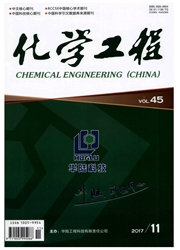

 中文摘要:
中文摘要:
为了有效提高CO2捕集过程中的传质效率,需要测量规整填料在不同溶液体系下的传质性能。在氢氧化钠水溶液-空气-CO2体系的基础上,通过向液相加入甘油的方法,使液相黏度由0.001 Pa·s最高增加至0.002 5 Pa·s。这一改变使实验体系更加接近真实的CO2吸收体系,如乙醇胺、二乙醇胺水溶液等。利用此改进后的体系,在直径为200 mm、填料高度为800 mm的填料塔中,测量了波纹倾角为45°、齿顶角为90°、波纹峰高为9 mm的金属板波纹规整填料在不同操作条件下的有效传质面积。实验结果显示:黏度的改变直接影响到填料在同等条件下的有效传质面积。在实验的基础上,将黏度参数关联到新的关联式中,可以有效预测在不同黏度体系下的有效传质面积,计算值与实验值吻合较好。
 英文摘要:
英文摘要:
In order to enhance the mass transfer efficiency in carbon capture process, it is important to obtain the performance of structured packing in different kinds of solvent systems. For the air-CO2-NaOH system, glycerol was added to the solution. Liquid viscosity was varied from 0. 001 Pa · s to 0. 002 5 Pa · s , making the liquid phase similar to the real CO2 absorbent in carbon capture and storage (CCS) system, e. g. , monoethanolamine (MEA), diethanolamine (DEA). Mass transfer experiments were conducted in a packed column with a diameter of 200 mm and a packing height of 800 mm. The effective mass transfer area of structured packing under a variety of conditions was tested, made with corrugated metal sheets, with its corrugation angles 45°, vertex angle 90°and thickness of the sheets 9 mm, respectively. Regarding effective mass transfer area, the results support the conclusion that change of viscosity has an effect on packing performance, which, though it is slight, cannot be ignored. New correlations for the effective mass transfer area are based on the operation conditions and liquid properties. The prediction shows a good agreement with the experimental results.
 同期刊论文项目
同期刊论文项目
 同项目期刊论文
同项目期刊论文
 Study on heat integration of supercritical coal-fired power plant with post-combustion CO2 capture p
Study on heat integration of supercritical coal-fired power plant with post-combustion CO2 capture p Upgrading the integration ofsupercriticalcoal-fired power plant with post-combustion CO2capture proc
Upgrading the integration ofsupercriticalcoal-fired power plant with post-combustion CO2capture proc Systematic study of aqueousmonoethanolamine-based CO2 capture process (I): model developmentand proc
Systematic study of aqueousmonoethanolamine-based CO2 capture process (I): model developmentand proc Heat integration of natural gas combined cycle power plant integrated with post-combustion CO2 captu
Heat integration of natural gas combined cycle power plant integrated with post-combustion CO2 captu 期刊信息
期刊信息
